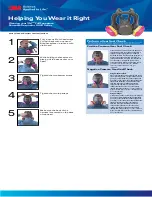
2. The limitations outlined in the applicable NIOSH approval.
3. Any applicable limitation contained in a standard established by a regulatory
agency (such as OSHA) with jurisdiction over the wearer.
4. Do not wear for protection against substances with poor warning properties or
those which generate high rates of reaction with sorbent material in the canister.
5. Mixtures of Contaminants — NIOSH allows this respirator to be used for pro-
tection against a mixture of contaminants that are present simultaneously or
alternately against one contaminant then another (using the same canister) if the
mixture meets the following conditions:
a. The canister must be approved for all contaminants present.
b. NIOSH permits mixing of the following contaminants: organic vapors, acid
gases, ammonia, chlorine dioxide, hydrogen sulfide, and carbon monoxide.
c. Particulates can be mixed with any other particulate or any gas or vapor for
which the canister is approved.
d. Contaminants present simultaneously must be below IDLH levels for the
specific contaminants. If any one contaminant in the mixture exceeds the
IDLH concentration then the entire mixture must be treated as IDLH and the
respirator cannot be used (except for escape).
Time Use Limitation
Canisters with an N95 filter shall be limited to 8 hours of use (continuous or inter-
mittent) against particulates. [Service time can be extended by performing an eval-
uation in the specific workplace setting that demonstrates (a) that the extended use
will not degrade the filter efficiency below 95% or (b) that the total mass loading of
the filter is less than 200 mg.]
EXPOSURE LIMITS
A listing of acceptable exposure limits from the following sources is provided in
MSA’s
Response
®
Respirator Selector
(available online at www.msanet.com):
•
American Conference of Governmental Industrial Hygienists (ACGIH)
•
Occupational Safety and Health Administration (OSHA)
•
National Institute for Occupational Safety and Health (NIOSH)
•
American Industrial Hygiene Association (AIHA)
Contact MSA at 1-800-MSA-2222 for information.
Exposure Limits for Mixtures
The American Conference of Governmental Industrial Hygienists (ACGIH) publish-
es the following information to determine the TLV of a mixture.
First, determine the total concentration of the chemical mixture (CMixture) from the
individual contaminant concentrations (C1, C2, C3, ...) using the following formula:
CMixture = C1 + C2 + C3 + ...
The TLV of the mixture is found by using the following formula where T1, T2, T3, ...
are the individual contaminant TLVs and C1, C2, C3, ... are the individual contami-
nant concentrations:
TAL 7012 (L) Rev. 2 - 818369
5
Содержание Duo-Flo
Страница 14: ...14 TAL 7012 L Rev 2 818369 Duo Flo Constant Flow Quick Disconnects for Flow Control Devices...
Страница 17: ...TAL 7012 L Rev 2 818369 17 Duo Flo Pressure Demand Quick Disconnects for Flow Control Devices...
Страница 20: ...20 TAL 7012 L Rev 2 818369...
Страница 21: ...TAL 7012 L Rev 2 818369 21...
Страница 22: ......
Страница 23: ......
Страница 24: ......




































